RBS's Strategic Response to Technological Disruption
VerifiedAdded on 2020/03/28
|12
|2681
|274
AI Summary
The rapid evolution of technology presents both challenges and opportunities for financial institutions like RBS. As digital transformation reshapes the banking landscape, RBS is proactively adapting to these changes by leveraging disruptive technologies such as mobile internet to enhance customer engagement and streamline operations. The bank's strategic goals include maintaining a strong capital ratio, issuing Additional Tier 1 (AT1) securities, and reducing operational expenses. Through initiatives like narrowing the gap in Net Promoter Scores (NPS) among UK brands and fostering sustainable growth through increased lending, RBS is positioning itself to meet evolving customer needs while managing costs effectively. These efforts reflect a broader industry trend where traditional banks must innovate to stay competitive amidst technological disruptions.
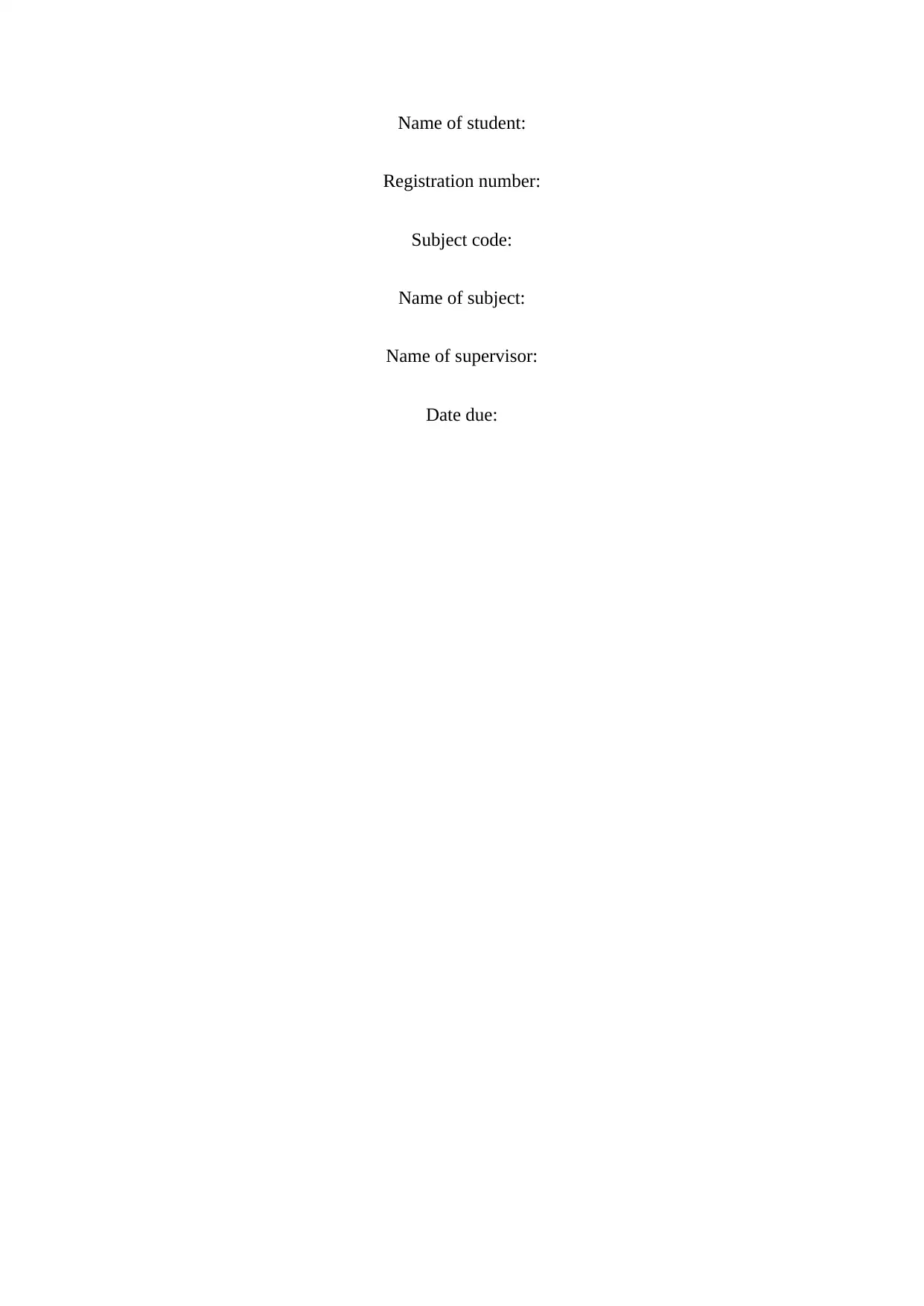
Name of student:
Registration number:
Subject code:
Name of subject:
Name of supervisor:
Date due:
Registration number:
Subject code:
Name of subject:
Name of supervisor:
Date due:
Paraphrase This Document
Need a fresh take? Get an instant paraphrase of this document with our AI Paraphraser
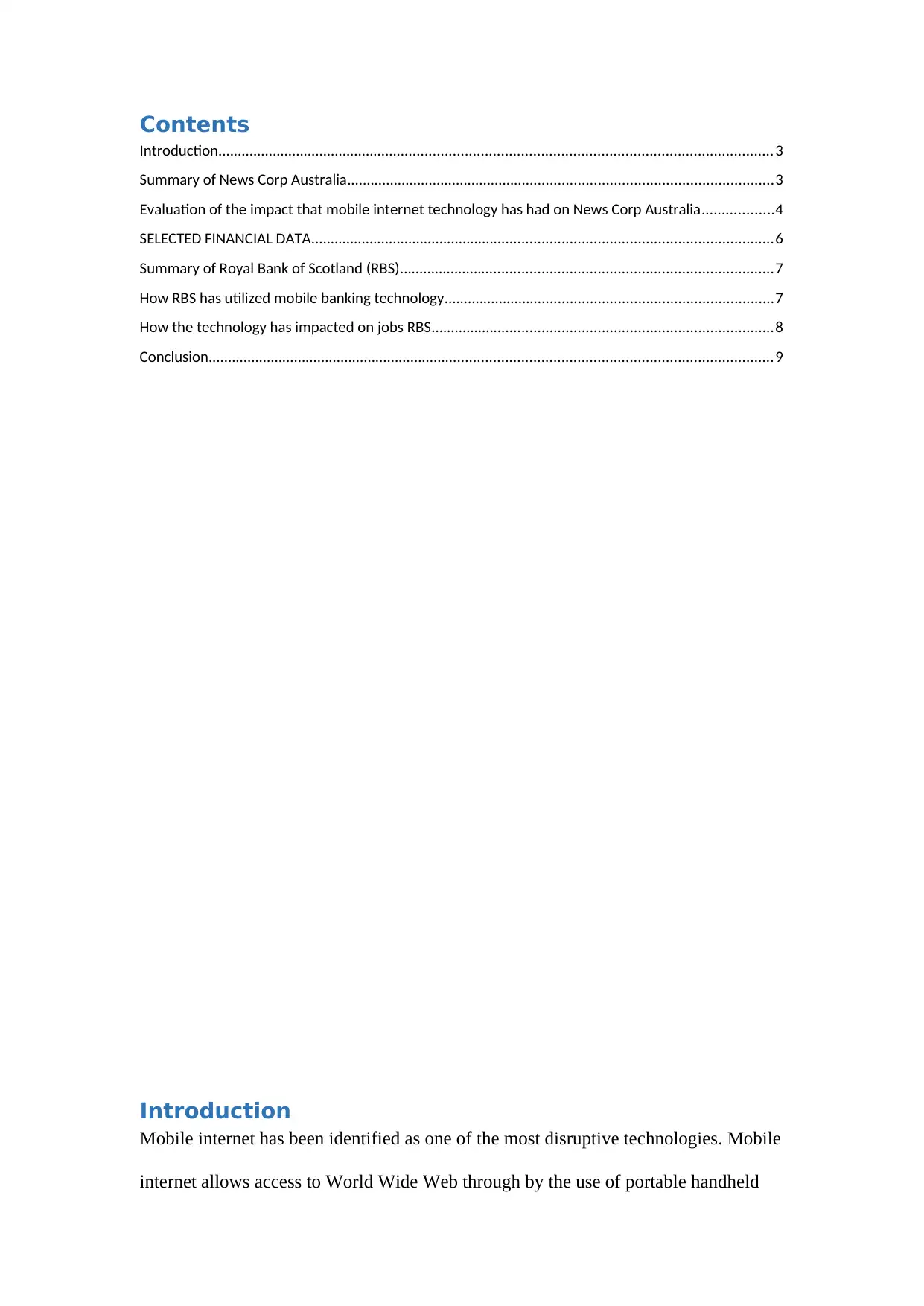
Contents
Introduction............................................................................................................................................3
Summary of News Corp Australia............................................................................................................3
Evaluation of the impact that mobile internet technology has had on News Corp Australia..................4
SELECTED FINANCIAL DATA.....................................................................................................................6
Summary of Royal Bank of Scotland (RBS)..............................................................................................7
How RBS has utilized mobile banking technology...................................................................................7
How the technology has impacted on jobs RBS......................................................................................8
Conclusion...............................................................................................................................................9
Introduction
Mobile internet has been identified as one of the most disruptive technologies. Mobile
internet allows access to World Wide Web through by the use of portable handheld
Introduction............................................................................................................................................3
Summary of News Corp Australia............................................................................................................3
Evaluation of the impact that mobile internet technology has had on News Corp Australia..................4
SELECTED FINANCIAL DATA.....................................................................................................................6
Summary of Royal Bank of Scotland (RBS)..............................................................................................7
How RBS has utilized mobile banking technology...................................................................................7
How the technology has impacted on jobs RBS......................................................................................8
Conclusion...............................................................................................................................................9
Introduction
Mobile internet has been identified as one of the most disruptive technologies. Mobile
internet allows access to World Wide Web through by the use of portable handheld
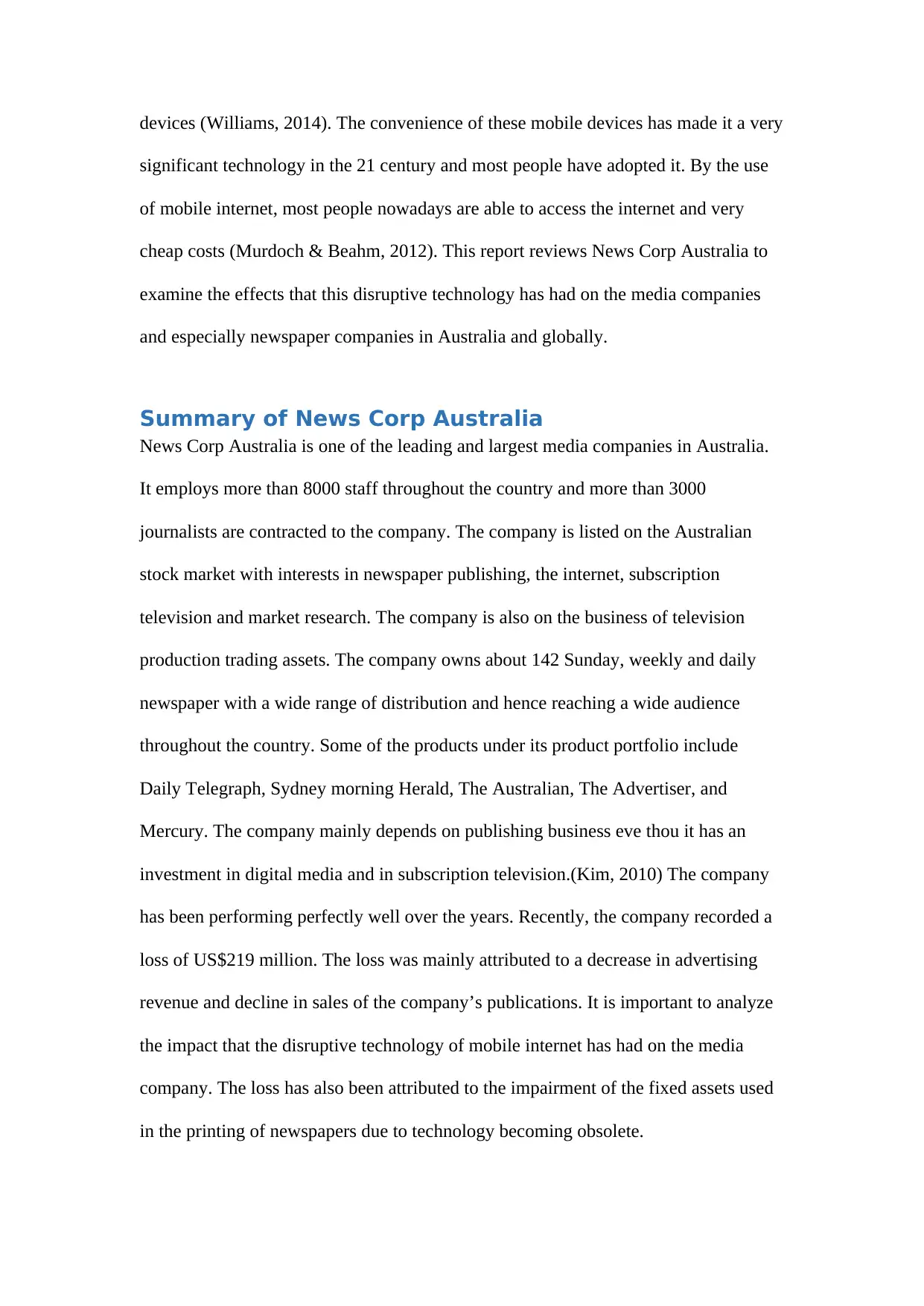
devices (Williams, 2014). The convenience of these mobile devices has made it a very
significant technology in the 21 century and most people have adopted it. By the use
of mobile internet, most people nowadays are able to access the internet and very
cheap costs (Murdoch & Beahm, 2012). This report reviews News Corp Australia to
examine the effects that this disruptive technology has had on the media companies
and especially newspaper companies in Australia and globally.
Summary of News Corp Australia
News Corp Australia is one of the leading and largest media companies in Australia.
It employs more than 8000 staff throughout the country and more than 3000
journalists are contracted to the company. The company is listed on the Australian
stock market with interests in newspaper publishing, the internet, subscription
television and market research. The company is also on the business of television
production trading assets. The company owns about 142 Sunday, weekly and daily
newspaper with a wide range of distribution and hence reaching a wide audience
throughout the country. Some of the products under its product portfolio include
Daily Telegraph, Sydney morning Herald, The Australian, The Advertiser, and
Mercury. The company mainly depends on publishing business eve thou it has an
investment in digital media and in subscription television.(Kim, 2010) The company
has been performing perfectly well over the years. Recently, the company recorded a
loss of US$219 million. The loss was mainly attributed to a decrease in advertising
revenue and decline in sales of the company’s publications. It is important to analyze
the impact that the disruptive technology of mobile internet has had on the media
company. The loss has also been attributed to the impairment of the fixed assets used
in the printing of newspapers due to technology becoming obsolete.
significant technology in the 21 century and most people have adopted it. By the use
of mobile internet, most people nowadays are able to access the internet and very
cheap costs (Murdoch & Beahm, 2012). This report reviews News Corp Australia to
examine the effects that this disruptive technology has had on the media companies
and especially newspaper companies in Australia and globally.
Summary of News Corp Australia
News Corp Australia is one of the leading and largest media companies in Australia.
It employs more than 8000 staff throughout the country and more than 3000
journalists are contracted to the company. The company is listed on the Australian
stock market with interests in newspaper publishing, the internet, subscription
television and market research. The company is also on the business of television
production trading assets. The company owns about 142 Sunday, weekly and daily
newspaper with a wide range of distribution and hence reaching a wide audience
throughout the country. Some of the products under its product portfolio include
Daily Telegraph, Sydney morning Herald, The Australian, The Advertiser, and
Mercury. The company mainly depends on publishing business eve thou it has an
investment in digital media and in subscription television.(Kim, 2010) The company
has been performing perfectly well over the years. Recently, the company recorded a
loss of US$219 million. The loss was mainly attributed to a decrease in advertising
revenue and decline in sales of the company’s publications. It is important to analyze
the impact that the disruptive technology of mobile internet has had on the media
company. The loss has also been attributed to the impairment of the fixed assets used
in the printing of newspapers due to technology becoming obsolete.
⊘ This is a preview!⊘
Do you want full access?
Subscribe today to unlock all pages.

Trusted by 1+ million students worldwide
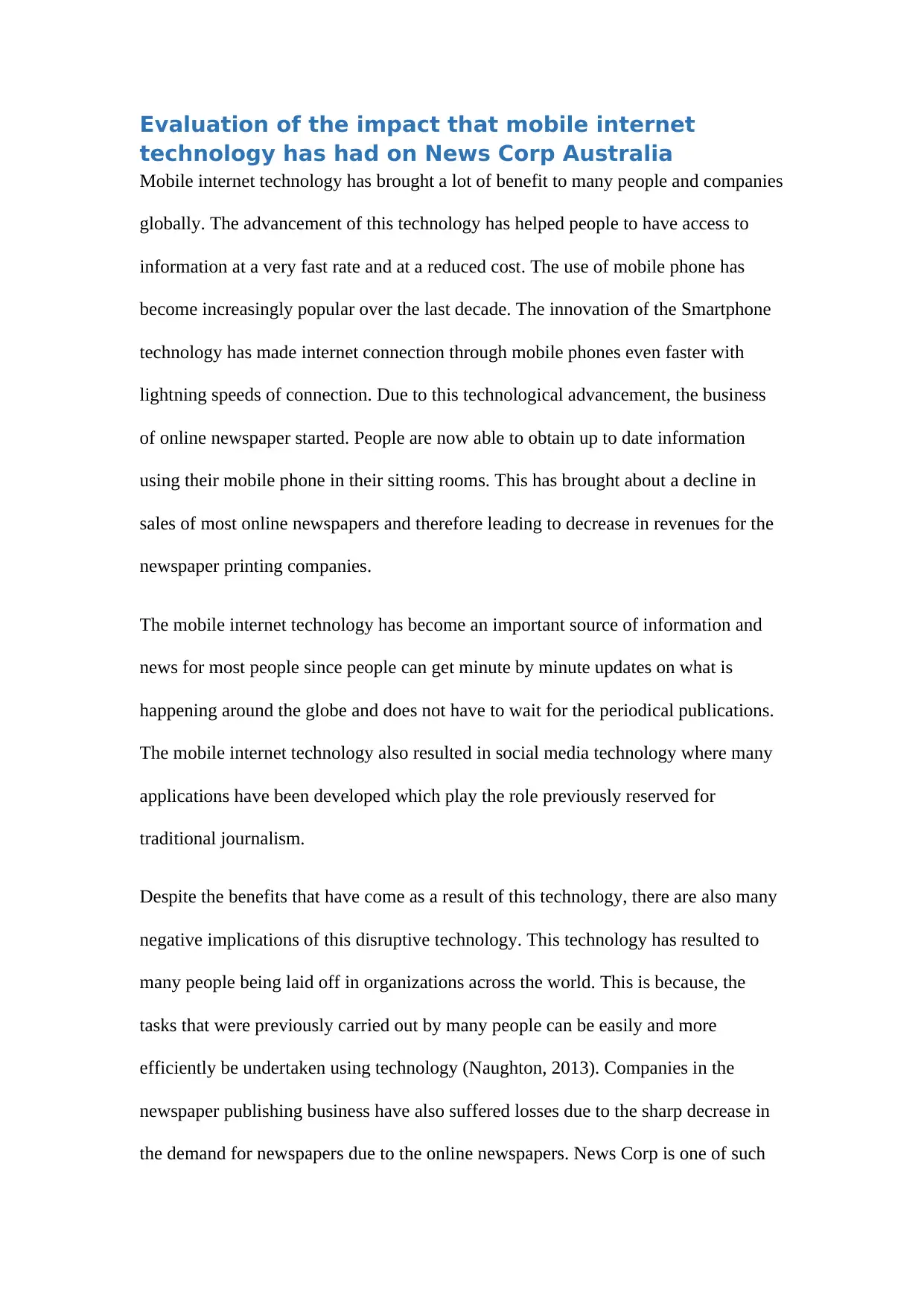
Evaluation of the impact that mobile internet
technology has had on News Corp Australia
Mobile internet technology has brought a lot of benefit to many people and companies
globally. The advancement of this technology has helped people to have access to
information at a very fast rate and at a reduced cost. The use of mobile phone has
become increasingly popular over the last decade. The innovation of the Smartphone
technology has made internet connection through mobile phones even faster with
lightning speeds of connection. Due to this technological advancement, the business
of online newspaper started. People are now able to obtain up to date information
using their mobile phone in their sitting rooms. This has brought about a decline in
sales of most online newspapers and therefore leading to decrease in revenues for the
newspaper printing companies.
The mobile internet technology has become an important source of information and
news for most people since people can get minute by minute updates on what is
happening around the globe and does not have to wait for the periodical publications.
The mobile internet technology also resulted in social media technology where many
applications have been developed which play the role previously reserved for
traditional journalism.
Despite the benefits that have come as a result of this technology, there are also many
negative implications of this disruptive technology. This technology has resulted to
many people being laid off in organizations across the world. This is because, the
tasks that were previously carried out by many people can be easily and more
efficiently be undertaken using technology (Naughton, 2013). Companies in the
newspaper publishing business have also suffered losses due to the sharp decrease in
the demand for newspapers due to the online newspapers. News Corp is one of such
technology has had on News Corp Australia
Mobile internet technology has brought a lot of benefit to many people and companies
globally. The advancement of this technology has helped people to have access to
information at a very fast rate and at a reduced cost. The use of mobile phone has
become increasingly popular over the last decade. The innovation of the Smartphone
technology has made internet connection through mobile phones even faster with
lightning speeds of connection. Due to this technological advancement, the business
of online newspaper started. People are now able to obtain up to date information
using their mobile phone in their sitting rooms. This has brought about a decline in
sales of most online newspapers and therefore leading to decrease in revenues for the
newspaper printing companies.
The mobile internet technology has become an important source of information and
news for most people since people can get minute by minute updates on what is
happening around the globe and does not have to wait for the periodical publications.
The mobile internet technology also resulted in social media technology where many
applications have been developed which play the role previously reserved for
traditional journalism.
Despite the benefits that have come as a result of this technology, there are also many
negative implications of this disruptive technology. This technology has resulted to
many people being laid off in organizations across the world. This is because, the
tasks that were previously carried out by many people can be easily and more
efficiently be undertaken using technology (Naughton, 2013). Companies in the
newspaper publishing business have also suffered losses due to the sharp decrease in
the demand for newspapers due to the online newspapers. News Corp is one of such
Paraphrase This Document
Need a fresh take? Get an instant paraphrase of this document with our AI Paraphraser
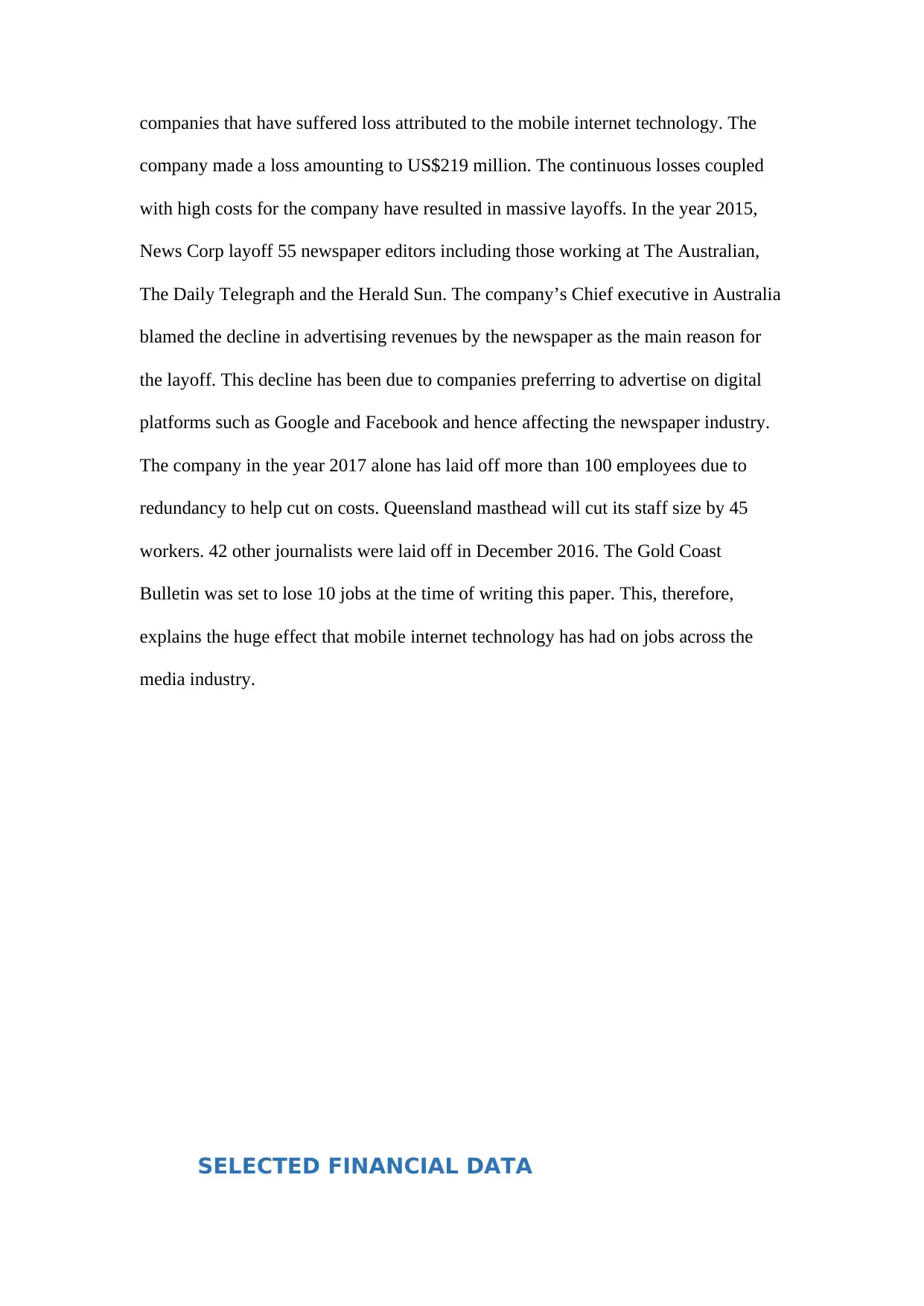
companies that have suffered loss attributed to the mobile internet technology. The
company made a loss amounting to US$219 million. The continuous losses coupled
with high costs for the company have resulted in massive layoffs. In the year 2015,
News Corp layoff 55 newspaper editors including those working at The Australian,
The Daily Telegraph and the Herald Sun. The company’s Chief executive in Australia
blamed the decline in advertising revenues by the newspaper as the main reason for
the layoff. This decline has been due to companies preferring to advertise on digital
platforms such as Google and Facebook and hence affecting the newspaper industry.
The company in the year 2017 alone has laid off more than 100 employees due to
redundancy to help cut on costs. Queensland masthead will cut its staff size by 45
workers. 42 other journalists were laid off in December 2016. The Gold Coast
Bulletin was set to lose 10 jobs at the time of writing this paper. This, therefore,
explains the huge effect that mobile internet technology has had on jobs across the
media industry.
SELECTED FINANCIAL DATA
company made a loss amounting to US$219 million. The continuous losses coupled
with high costs for the company have resulted in massive layoffs. In the year 2015,
News Corp layoff 55 newspaper editors including those working at The Australian,
The Daily Telegraph and the Herald Sun. The company’s Chief executive in Australia
blamed the decline in advertising revenues by the newspaper as the main reason for
the layoff. This decline has been due to companies preferring to advertise on digital
platforms such as Google and Facebook and hence affecting the newspaper industry.
The company in the year 2017 alone has laid off more than 100 employees due to
redundancy to help cut on costs. Queensland masthead will cut its staff size by 45
workers. 42 other journalists were laid off in December 2016. The Gold Coast
Bulletin was set to lose 10 jobs at the time of writing this paper. This, therefore,
explains the huge effect that mobile internet technology has had on jobs across the
media industry.
SELECTED FINANCIAL DATA
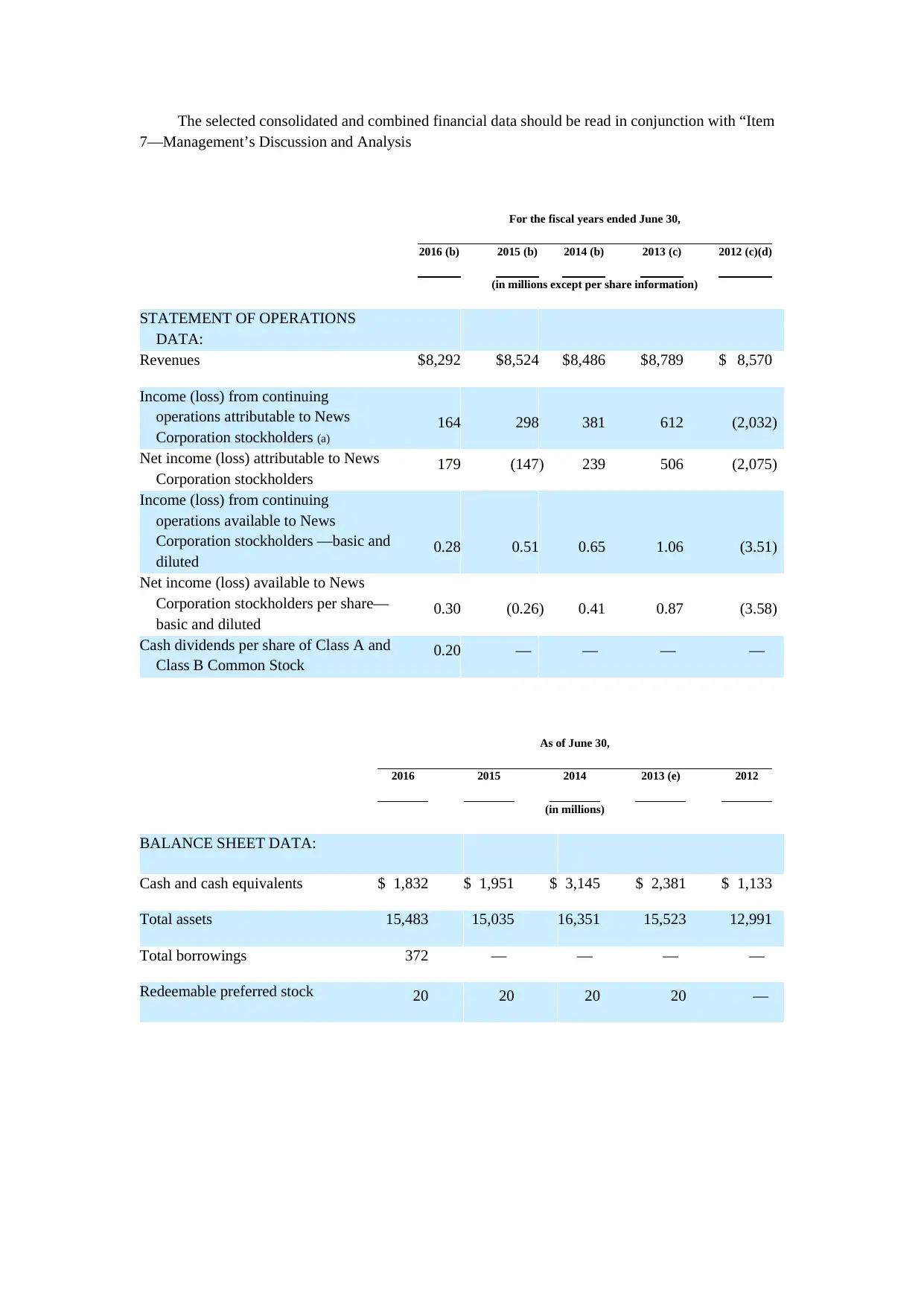
The selected consolidated and combined financial data should be read in conjunction with “Item
7—Management’s Discussion and Analysis
For the fiscal years ended June 30,
2016 (b) 2015 (b) 2014 (b) 2013 (c) 2012 (c)(d)
(in millions except per share information)
STATEMENT OF OPERATIONS
DATA:
Revenues $8,292 $8,524 $8,486 $8,789 $ 8,570
Income (loss) from continuing
operations attributable to News
Corporation stockholders (a)
164 298 381 612 (2,032 )
Net income (loss) attributable to News
Corporation stockholders 179 (147) 239 506 (2,075 )
Income (loss) from continuing
operations available to News
Corporation stockholders —basic and
diluted 0.28 0.51 0.65 1.06 (3.51 )
Net income (loss) available to News
Corporation stockholders per share—
basic and diluted 0.30 (0.26) 0.41 0.87 (3.58 )
Cash dividends per share of Class A and
Class B Common Stock 0.20 — — — —
As of June 30,
2016 2015 2014 2013 (e) 2012
(in millions)
BALANCE SHEET DATA:
Cash and cash equivalents $ 1,832 $ 1,951 $ 3,145 $ 2,381 $ 1,133
Total assets 15,483 15,035 16,351 15,523 12,991
Total borrowings 372 — — — —
Redeemable preferred stock 20 20 20 20 —
7—Management’s Discussion and Analysis
For the fiscal years ended June 30,
2016 (b) 2015 (b) 2014 (b) 2013 (c) 2012 (c)(d)
(in millions except per share information)
STATEMENT OF OPERATIONS
DATA:
Revenues $8,292 $8,524 $8,486 $8,789 $ 8,570
Income (loss) from continuing
operations attributable to News
Corporation stockholders (a)
164 298 381 612 (2,032 )
Net income (loss) attributable to News
Corporation stockholders 179 (147) 239 506 (2,075 )
Income (loss) from continuing
operations available to News
Corporation stockholders —basic and
diluted 0.28 0.51 0.65 1.06 (3.51 )
Net income (loss) available to News
Corporation stockholders per share—
basic and diluted 0.30 (0.26) 0.41 0.87 (3.58 )
Cash dividends per share of Class A and
Class B Common Stock 0.20 — — — —
As of June 30,
2016 2015 2014 2013 (e) 2012
(in millions)
BALANCE SHEET DATA:
Cash and cash equivalents $ 1,832 $ 1,951 $ 3,145 $ 2,381 $ 1,133
Total assets 15,483 15,035 16,351 15,523 12,991
Total borrowings 372 — — — —
Redeemable preferred stock 20 20 20 20 —
⊘ This is a preview!⊘
Do you want full access?
Subscribe today to unlock all pages.

Trusted by 1+ million students worldwide
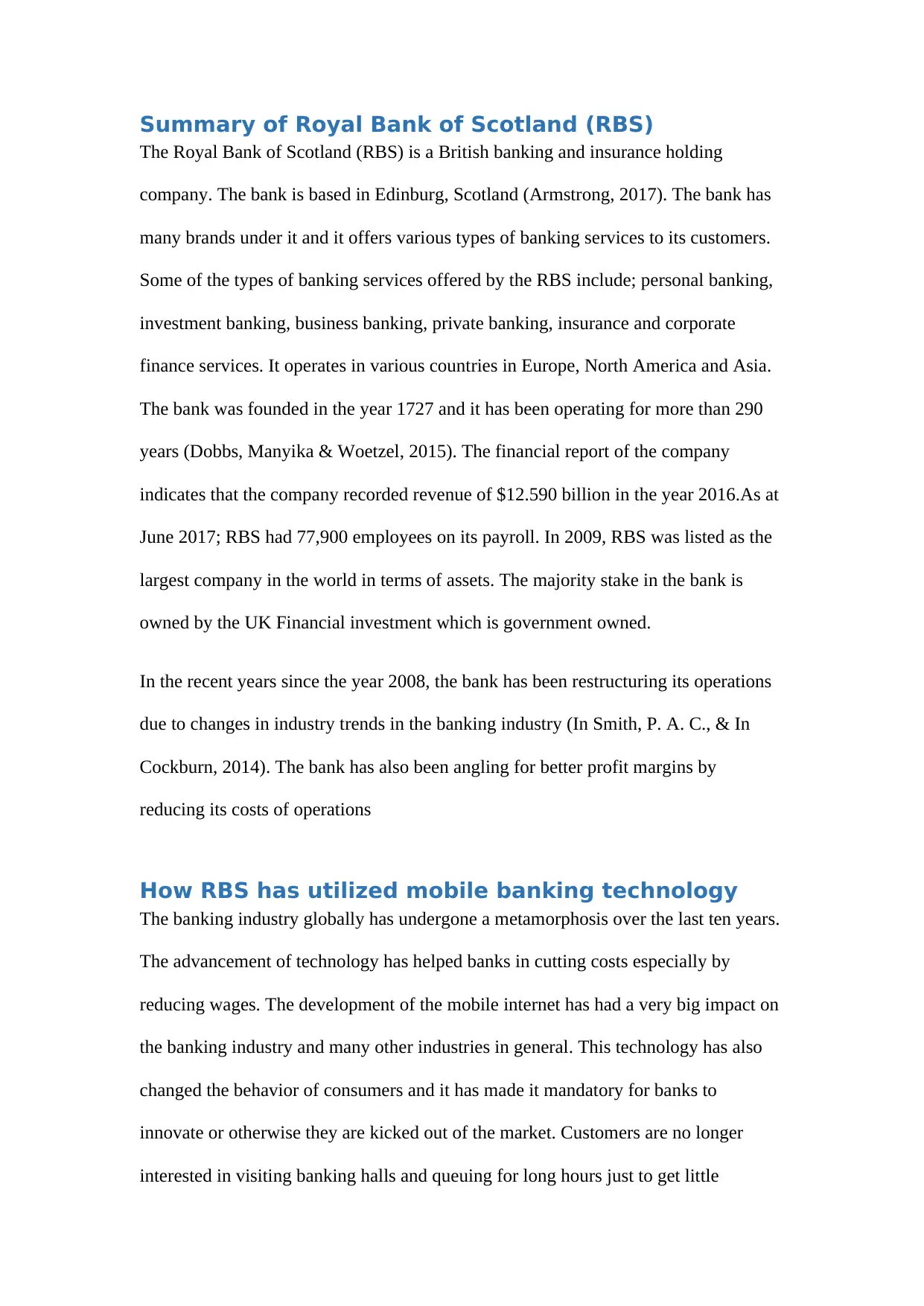
Summary of Royal Bank of Scotland (RBS)
The Royal Bank of Scotland (RBS) is a British banking and insurance holding
company. The bank is based in Edinburg, Scotland (Armstrong, 2017). The bank has
many brands under it and it offers various types of banking services to its customers.
Some of the types of banking services offered by the RBS include; personal banking,
investment banking, business banking, private banking, insurance and corporate
finance services. It operates in various countries in Europe, North America and Asia.
The bank was founded in the year 1727 and it has been operating for more than 290
years (Dobbs, Manyika & Woetzel, 2015). The financial report of the company
indicates that the company recorded revenue of $12.590 billion in the year 2016.As at
June 2017; RBS had 77,900 employees on its payroll. In 2009, RBS was listed as the
largest company in the world in terms of assets. The majority stake in the bank is
owned by the UK Financial investment which is government owned.
In the recent years since the year 2008, the bank has been restructuring its operations
due to changes in industry trends in the banking industry (In Smith, P. A. C., & In
Cockburn, 2014). The bank has also been angling for better profit margins by
reducing its costs of operations
How RBS has utilized mobile banking technology
The banking industry globally has undergone a metamorphosis over the last ten years.
The advancement of technology has helped banks in cutting costs especially by
reducing wages. The development of the mobile internet has had a very big impact on
the banking industry and many other industries in general. This technology has also
changed the behavior of consumers and it has made it mandatory for banks to
innovate or otherwise they are kicked out of the market. Customers are no longer
interested in visiting banking halls and queuing for long hours just to get little
The Royal Bank of Scotland (RBS) is a British banking and insurance holding
company. The bank is based in Edinburg, Scotland (Armstrong, 2017). The bank has
many brands under it and it offers various types of banking services to its customers.
Some of the types of banking services offered by the RBS include; personal banking,
investment banking, business banking, private banking, insurance and corporate
finance services. It operates in various countries in Europe, North America and Asia.
The bank was founded in the year 1727 and it has been operating for more than 290
years (Dobbs, Manyika & Woetzel, 2015). The financial report of the company
indicates that the company recorded revenue of $12.590 billion in the year 2016.As at
June 2017; RBS had 77,900 employees on its payroll. In 2009, RBS was listed as the
largest company in the world in terms of assets. The majority stake in the bank is
owned by the UK Financial investment which is government owned.
In the recent years since the year 2008, the bank has been restructuring its operations
due to changes in industry trends in the banking industry (In Smith, P. A. C., & In
Cockburn, 2014). The bank has also been angling for better profit margins by
reducing its costs of operations
How RBS has utilized mobile banking technology
The banking industry globally has undergone a metamorphosis over the last ten years.
The advancement of technology has helped banks in cutting costs especially by
reducing wages. The development of the mobile internet has had a very big impact on
the banking industry and many other industries in general. This technology has also
changed the behavior of consumers and it has made it mandatory for banks to
innovate or otherwise they are kicked out of the market. Customers are no longer
interested in visiting banking halls and queuing for long hours just to get little
Paraphrase This Document
Need a fresh take? Get an instant paraphrase of this document with our AI Paraphraser
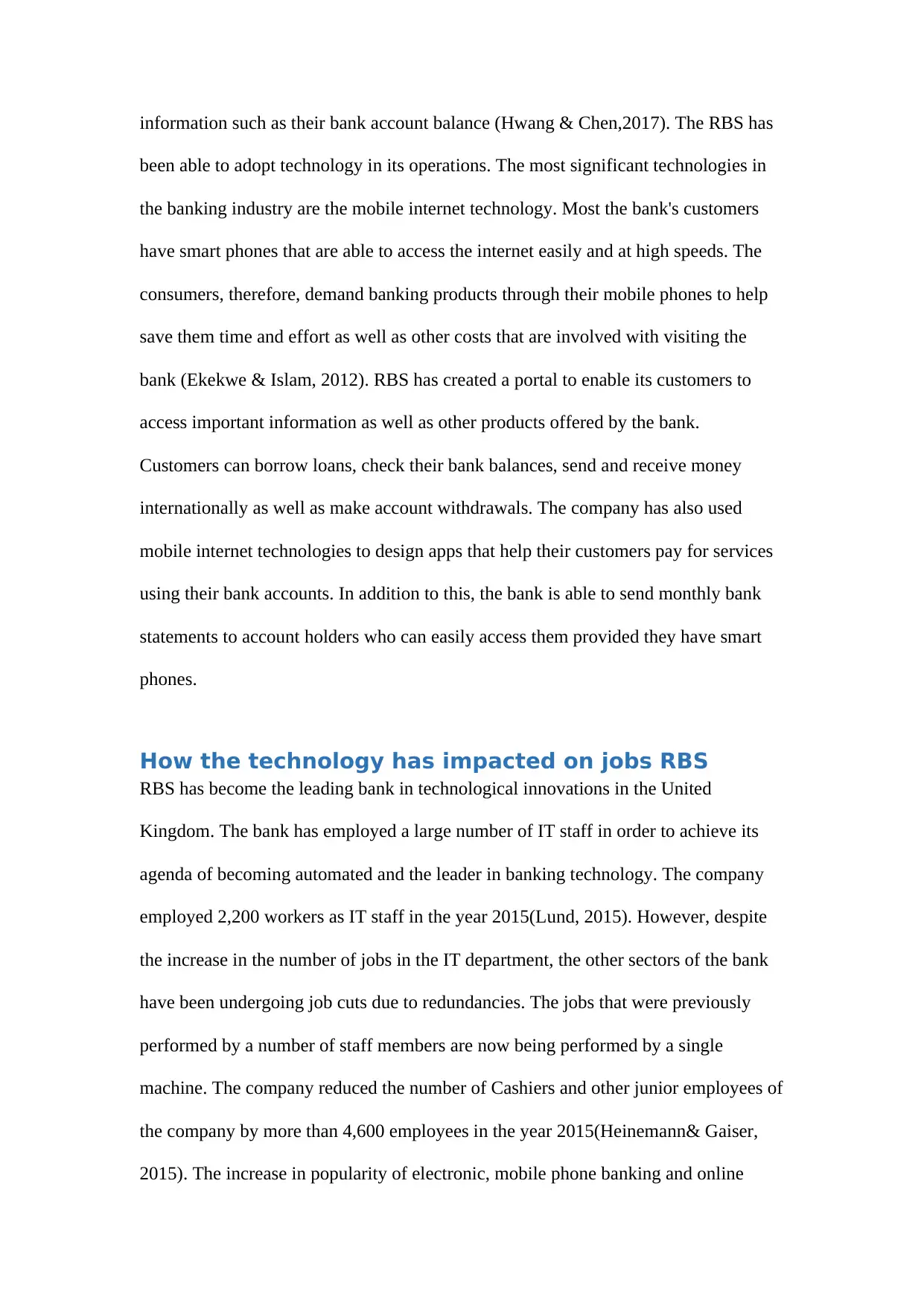
information such as their bank account balance (Hwang & Chen,2017). The RBS has
been able to adopt technology in its operations. The most significant technologies in
the banking industry are the mobile internet technology. Most the bank's customers
have smart phones that are able to access the internet easily and at high speeds. The
consumers, therefore, demand banking products through their mobile phones to help
save them time and effort as well as other costs that are involved with visiting the
bank (Ekekwe & Islam, 2012). RBS has created a portal to enable its customers to
access important information as well as other products offered by the bank.
Customers can borrow loans, check their bank balances, send and receive money
internationally as well as make account withdrawals. The company has also used
mobile internet technologies to design apps that help their customers pay for services
using their bank accounts. In addition to this, the bank is able to send monthly bank
statements to account holders who can easily access them provided they have smart
phones.
How the technology has impacted on jobs RBS
RBS has become the leading bank in technological innovations in the United
Kingdom. The bank has employed a large number of IT staff in order to achieve its
agenda of becoming automated and the leader in banking technology. The company
employed 2,200 workers as IT staff in the year 2015(Lund, 2015). However, despite
the increase in the number of jobs in the IT department, the other sectors of the bank
have been undergoing job cuts due to redundancies. The jobs that were previously
performed by a number of staff members are now being performed by a single
machine. The company reduced the number of Cashiers and other junior employees of
the company by more than 4,600 employees in the year 2015(Heinemann& Gaiser,
2015). The increase in popularity of electronic, mobile phone banking and online
been able to adopt technology in its operations. The most significant technologies in
the banking industry are the mobile internet technology. Most the bank's customers
have smart phones that are able to access the internet easily and at high speeds. The
consumers, therefore, demand banking products through their mobile phones to help
save them time and effort as well as other costs that are involved with visiting the
bank (Ekekwe & Islam, 2012). RBS has created a portal to enable its customers to
access important information as well as other products offered by the bank.
Customers can borrow loans, check their bank balances, send and receive money
internationally as well as make account withdrawals. The company has also used
mobile internet technologies to design apps that help their customers pay for services
using their bank accounts. In addition to this, the bank is able to send monthly bank
statements to account holders who can easily access them provided they have smart
phones.
How the technology has impacted on jobs RBS
RBS has become the leading bank in technological innovations in the United
Kingdom. The bank has employed a large number of IT staff in order to achieve its
agenda of becoming automated and the leader in banking technology. The company
employed 2,200 workers as IT staff in the year 2015(Lund, 2015). However, despite
the increase in the number of jobs in the IT department, the other sectors of the bank
have been undergoing job cuts due to redundancies. The jobs that were previously
performed by a number of staff members are now being performed by a single
machine. The company reduced the number of Cashiers and other junior employees of
the company by more than 4,600 employees in the year 2015(Heinemann& Gaiser,
2015). The increase in popularity of electronic, mobile phone banking and online
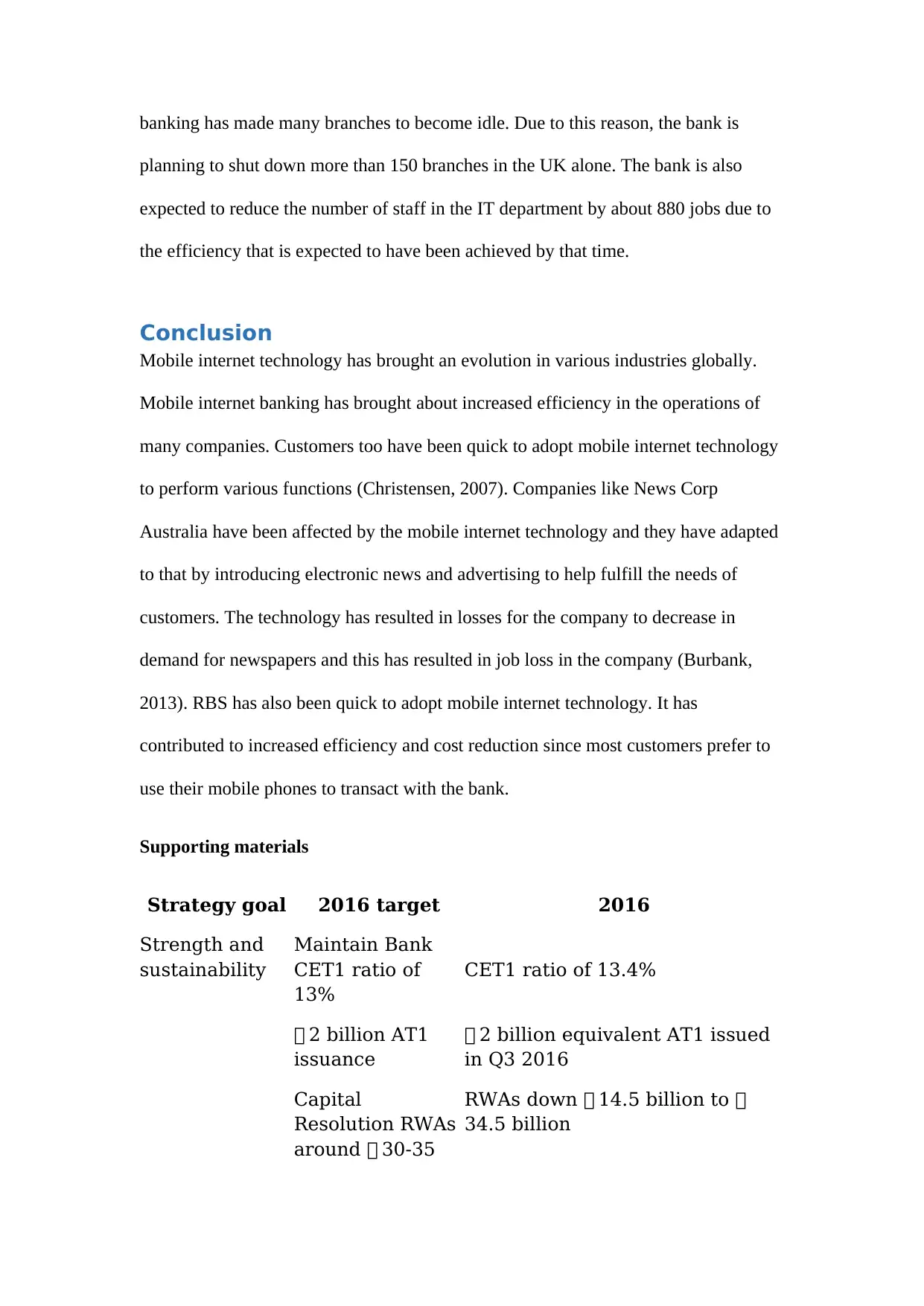
banking has made many branches to become idle. Due to this reason, the bank is
planning to shut down more than 150 branches in the UK alone. The bank is also
expected to reduce the number of staff in the IT department by about 880 jobs due to
the efficiency that is expected to have been achieved by that time.
Conclusion
Mobile internet technology has brought an evolution in various industries globally.
Mobile internet banking has brought about increased efficiency in the operations of
many companies. Customers too have been quick to adopt mobile internet technology
to perform various functions (Christensen, 2007). Companies like News Corp
Australia have been affected by the mobile internet technology and they have adapted
to that by introducing electronic news and advertising to help fulfill the needs of
customers. The technology has resulted in losses for the company to decrease in
demand for newspapers and this has resulted in job loss in the company (Burbank,
2013). RBS has also been quick to adopt mobile internet technology. It has
contributed to increased efficiency and cost reduction since most customers prefer to
use their mobile phones to transact with the bank.
Supporting materials
Strategy goal 2016 target 2016
Strength and
sustainability
Maintain Bank
CET1 ratio of
13%
CET1 ratio of 13.4%
拢 2 billion AT1
issuance
拢 2 billion equivalent AT1 issued
in Q3 2016
Capital
Resolution RWAs
around 拢 30-35
RWAs down 拢 14.5 billion to 拢
34.5 billion
planning to shut down more than 150 branches in the UK alone. The bank is also
expected to reduce the number of staff in the IT department by about 880 jobs due to
the efficiency that is expected to have been achieved by that time.
Conclusion
Mobile internet technology has brought an evolution in various industries globally.
Mobile internet banking has brought about increased efficiency in the operations of
many companies. Customers too have been quick to adopt mobile internet technology
to perform various functions (Christensen, 2007). Companies like News Corp
Australia have been affected by the mobile internet technology and they have adapted
to that by introducing electronic news and advertising to help fulfill the needs of
customers. The technology has resulted in losses for the company to decrease in
demand for newspapers and this has resulted in job loss in the company (Burbank,
2013). RBS has also been quick to adopt mobile internet technology. It has
contributed to increased efficiency and cost reduction since most customers prefer to
use their mobile phones to transact with the bank.
Supporting materials
Strategy goal 2016 target 2016
Strength and
sustainability
Maintain Bank
CET1 ratio of
13%
CET1 ratio of 13.4%
拢 2 billion AT1
issuance
拢 2 billion equivalent AT1 issued
in Q3 2016
Capital
Resolution RWAs
around 拢 30-35
RWAs down 拢 14.5 billion to 拢
34.5 billion
⊘ This is a preview!⊘
Do you want full access?
Subscribe today to unlock all pages.

Trusted by 1+ million students worldwide
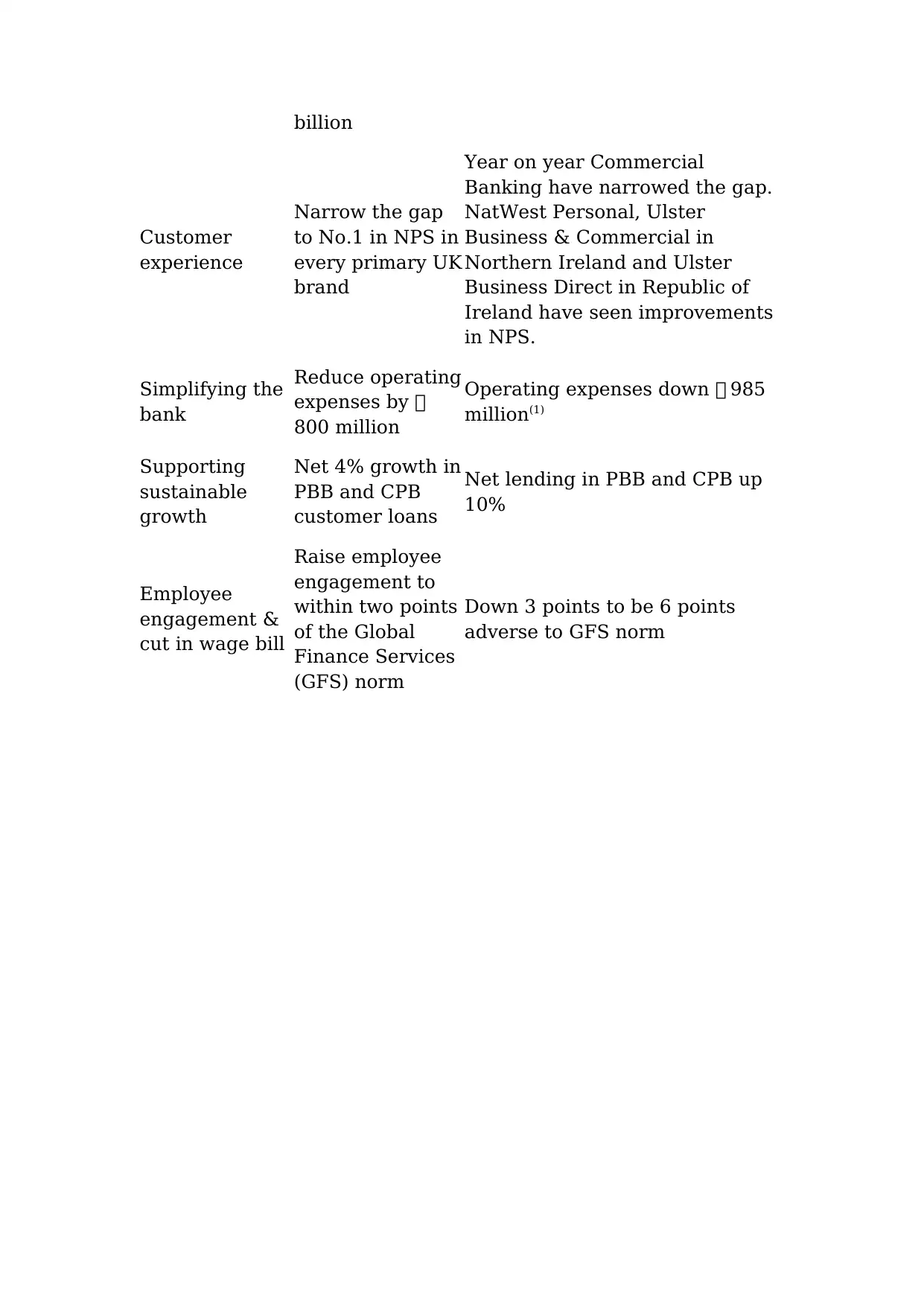
billion
Customer
experience
Narrow the gap
to No.1 in NPS in
every primary UK
brand
Year on year Commercial
Banking have narrowed the gap.
NatWest Personal, Ulster
Business & Commercial in
Northern Ireland and Ulster
Business Direct in Republic of
Ireland have seen improvements
in NPS.
Simplifying the
bank
Reduce operating
expenses by 拢
800 million
Operating expenses down 拢 985
million(1)
Supporting
sustainable
growth
Net 4% growth in
PBB and CPB
customer loans
Net lending in PBB and CPB up
10%
Employee
engagement &
cut in wage bill
Raise employee
engagement to
within two points
of the Global
Finance Services
(GFS) norm
Down 3 points to be 6 points
adverse to GFS norm
Customer
experience
Narrow the gap
to No.1 in NPS in
every primary UK
brand
Year on year Commercial
Banking have narrowed the gap.
NatWest Personal, Ulster
Business & Commercial in
Northern Ireland and Ulster
Business Direct in Republic of
Ireland have seen improvements
in NPS.
Simplifying the
bank
Reduce operating
expenses by 拢
800 million
Operating expenses down 拢 985
million(1)
Supporting
sustainable
growth
Net 4% growth in
PBB and CPB
customer loans
Net lending in PBB and CPB up
10%
Employee
engagement &
cut in wage bill
Raise employee
engagement to
within two points
of the Global
Finance Services
(GFS) norm
Down 3 points to be 6 points
adverse to GFS norm
Paraphrase This Document
Need a fresh take? Get an instant paraphrase of this document with our AI Paraphraser
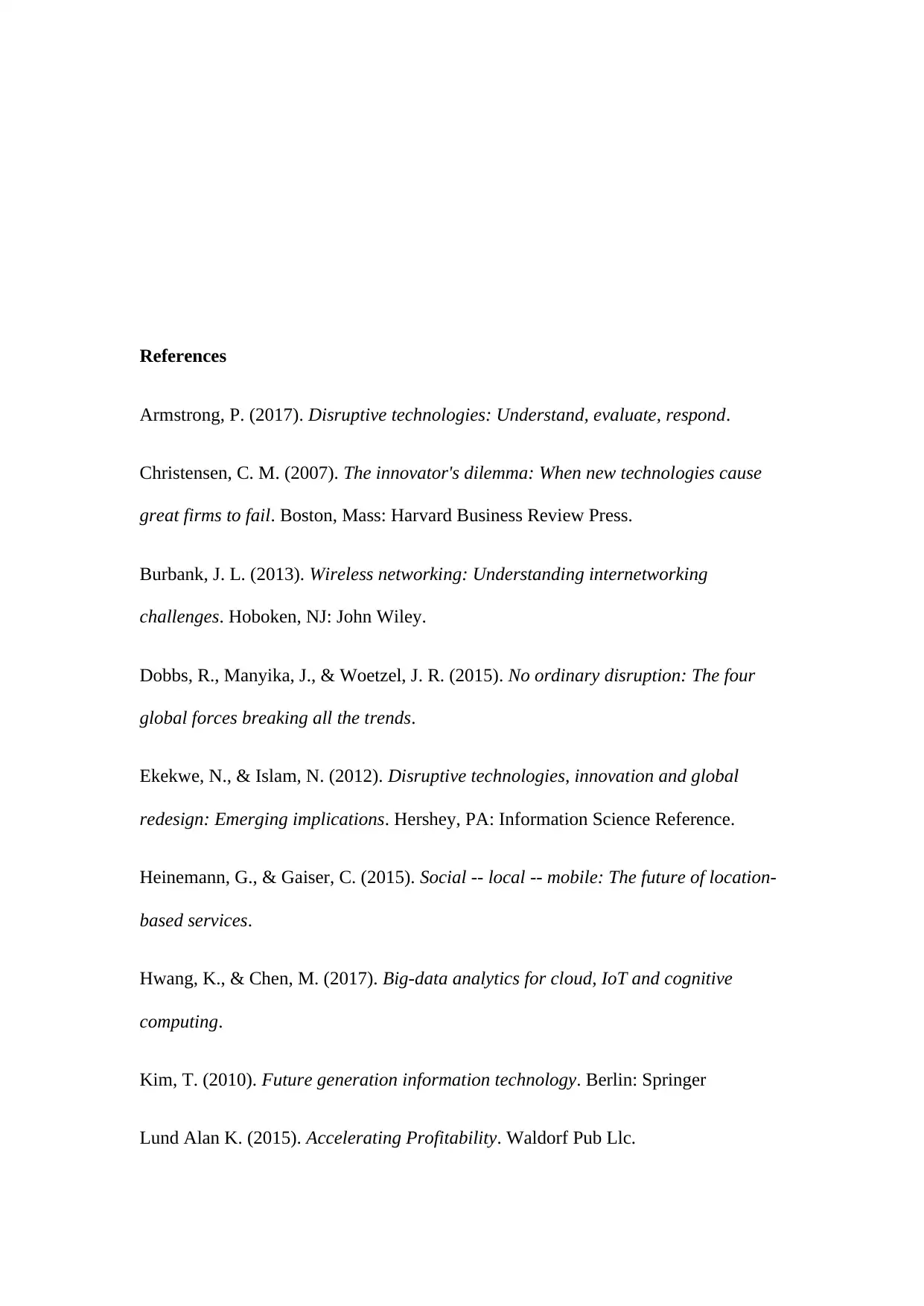
References
Armstrong, P. (2017). Disruptive technologies: Understand, evaluate, respond.
Christensen, C. M. (2007). The innovator's dilemma: When new technologies cause
great firms to fail. Boston, Mass: Harvard Business Review Press.
Burbank, J. L. (2013). Wireless networking: Understanding internetworking
challenges. Hoboken, NJ: John Wiley.
Dobbs, R., Manyika, J., & Woetzel, J. R. (2015). No ordinary disruption: The four
global forces breaking all the trends.
Ekekwe, N., & Islam, N. (2012). Disruptive technologies, innovation and global
redesign: Emerging implications. Hershey, PA: Information Science Reference.
Heinemann, G., & Gaiser, C. (2015). Social -- local -- mobile: The future of location-
based services.
Hwang, K., & Chen, M. (2017). Big-data analytics for cloud, IoT and cognitive
computing.
Kim, T. (2010). Future generation information technology. Berlin: Springer
Lund Alan K. (2015). Accelerating Profitability. Waldorf Pub Llc.
Armstrong, P. (2017). Disruptive technologies: Understand, evaluate, respond.
Christensen, C. M. (2007). The innovator's dilemma: When new technologies cause
great firms to fail. Boston, Mass: Harvard Business Review Press.
Burbank, J. L. (2013). Wireless networking: Understanding internetworking
challenges. Hoboken, NJ: John Wiley.
Dobbs, R., Manyika, J., & Woetzel, J. R. (2015). No ordinary disruption: The four
global forces breaking all the trends.
Ekekwe, N., & Islam, N. (2012). Disruptive technologies, innovation and global
redesign: Emerging implications. Hershey, PA: Information Science Reference.
Heinemann, G., & Gaiser, C. (2015). Social -- local -- mobile: The future of location-
based services.
Hwang, K., & Chen, M. (2017). Big-data analytics for cloud, IoT and cognitive
computing.
Kim, T. (2010). Future generation information technology. Berlin: Springer
Lund Alan K. (2015). Accelerating Profitability. Waldorf Pub Llc.
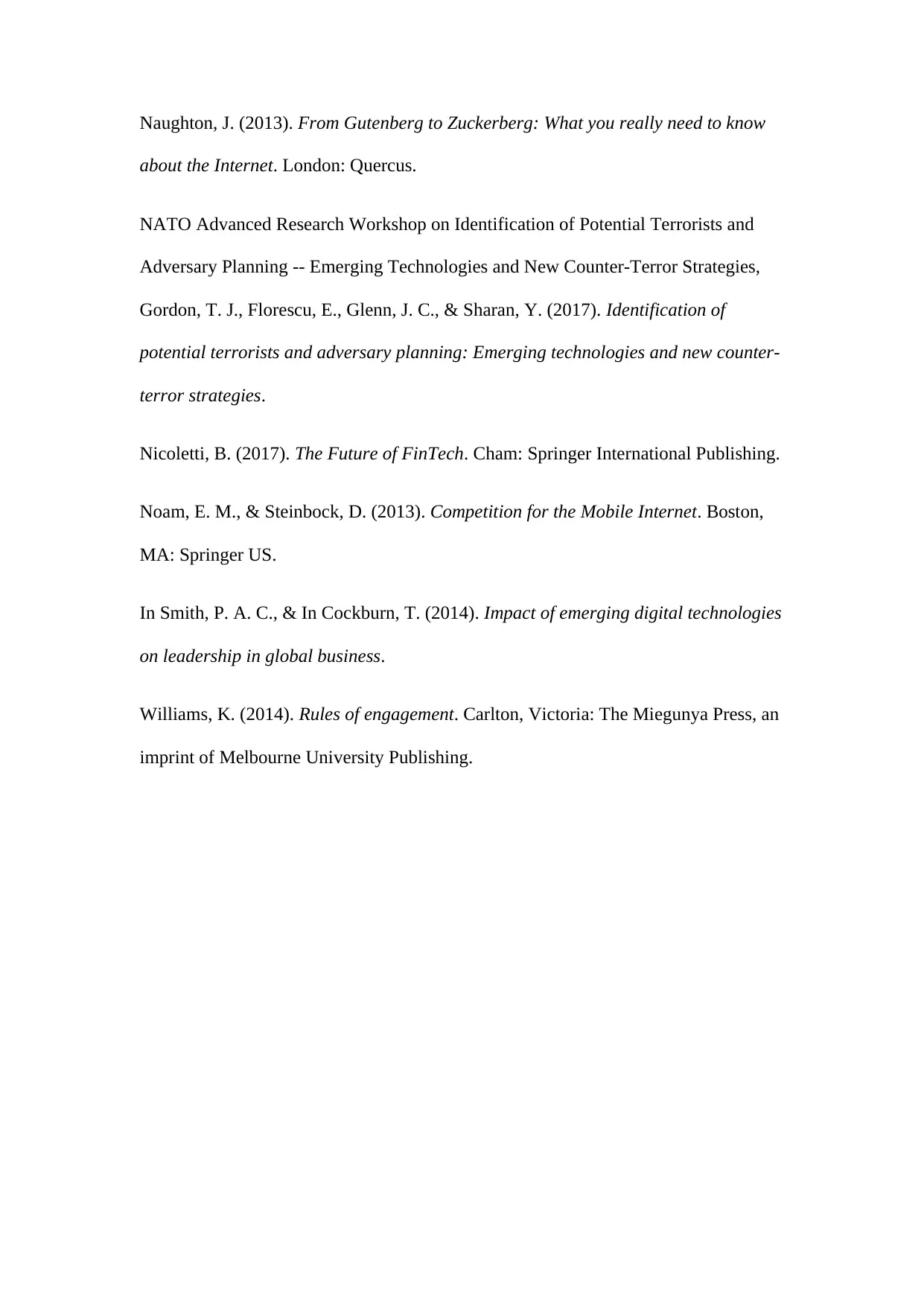
Naughton, J. (2013). From Gutenberg to Zuckerberg: What you really need to know
about the Internet. London: Quercus.
NATO Advanced Research Workshop on Identification of Potential Terrorists and
Adversary Planning -- Emerging Technologies and New Counter-Terror Strategies,
Gordon, T. J., Florescu, E., Glenn, J. C., & Sharan, Y. (2017). Identification of
potential terrorists and adversary planning: Emerging technologies and new counter-
terror strategies.
Nicoletti, B. (2017). The Future of FinTech. Cham: Springer International Publishing.
Noam, E. M., & Steinbock, D. (2013). Competition for the Mobile Internet. Boston,
MA: Springer US.
In Smith, P. A. C., & In Cockburn, T. (2014). Impact of emerging digital technologies
on leadership in global business.
Williams, K. (2014). Rules of engagement. Carlton, Victoria: The Miegunya Press, an
imprint of Melbourne University Publishing.
about the Internet. London: Quercus.
NATO Advanced Research Workshop on Identification of Potential Terrorists and
Adversary Planning -- Emerging Technologies and New Counter-Terror Strategies,
Gordon, T. J., Florescu, E., Glenn, J. C., & Sharan, Y. (2017). Identification of
potential terrorists and adversary planning: Emerging technologies and new counter-
terror strategies.
Nicoletti, B. (2017). The Future of FinTech. Cham: Springer International Publishing.
Noam, E. M., & Steinbock, D. (2013). Competition for the Mobile Internet. Boston,
MA: Springer US.
In Smith, P. A. C., & In Cockburn, T. (2014). Impact of emerging digital technologies
on leadership in global business.
Williams, K. (2014). Rules of engagement. Carlton, Victoria: The Miegunya Press, an
imprint of Melbourne University Publishing.
⊘ This is a preview!⊘
Do you want full access?
Subscribe today to unlock all pages.

Trusted by 1+ million students worldwide
1 out of 12
Related Documents
Your All-in-One AI-Powered Toolkit for Academic Success.
+13062052269
info@desklib.com
Available 24*7 on WhatsApp / Email
![[object Object]](/_next/static/media/star-bottom.7253800d.svg)
Unlock your academic potential
Copyright © 2020–2025 A2Z Services. All Rights Reserved. Developed and managed by ZUCOL.




